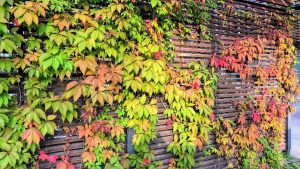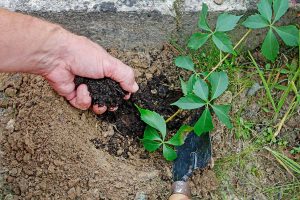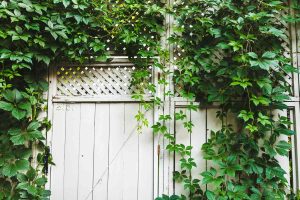The Virginia creeper is a fast-growing vine known for its strong wall-clinging ability. Initially green, its leaves turn a beautiful red in autumn. It is commonly planted to cover walls, fences, or house surfaces. Here’s our guide on how to grow virginia creeper.

Understanding Virginia Creeper
Virginia Creeper is a versatile, deciduous vine that can grow up to 50 feet tall if left unchecked. It’s known for its ability to quickly cover fences, trellises, and even walls, thanks to its strong adhesive tendrils. The leaves are typically composed of five leaflets, giving it a distinctive star-like appearance. In autumn, the leaves turn a stunning shade of red, making it a favorite among gardeners looking to add seasonal color to their landscape.
This plant is also beneficial for wildlife, providing shelter and food for birds and other creatures. Moreover, Virginia Creeper is low-maintenance, making it an ideal choice for both novice and experienced gardeners.
How to grow virginia creeper
Here’s a step-by-step guide on how to plant and care for Virginia creeper to ensure optimal growth and health.
Soil preparation

Before planting Virginia creeper, prepare the soil thoroughly. Choose a planting site that receives either full sun or partial shade. Virginia creeper grows well in a wide range of soil types but prefers moist, well-drained soil. Remove any weeds and debris from the planting area and loosen the soil to a depth of about 12 inches (30 cm) to promote healthy root development.
Digging the planting hole
Dig a hole that is slightly wider and deeper than the root ball of your Virginia creeper plant. The depth of the hole should be such that the top of the root ball sits level with the surrounding soil once the plant is placed inside.
Planting process
Carefully remove the Virginia creeper from its container and gently tease the roots apart if they are pot-bound. Place the plant into the prepared hole, ensuring it is positioned upright and oriented towards the structure it will climb. Backfill the hole with the excavated soil, gently firming it around the root ball to eliminate air pockets.
Watering requirements
Immediately after planting, water the Virginia creeper thoroughly to settle the soil and hydrate the roots. Throughout the growing season, maintain consistent soil moisture by watering regularly, especially during periods of dry weather. Avoid overwatering, as Virginia creeper prefers slightly moist soil rather than waterlogged conditions.
Fertilization needs
Incorporate organic matter such as compost or well-aged manure into the soil at planting time to enrich the soil and provide essential nutrients. Fertilize Virginia creeper in early spring before new growth begins and again in mid-summer to support vigorous foliage development and flowering.
Supporting the vine
Virginia creeper naturally climbs using tendrils equipped with adhesive pads that allow it to cling to vertical surfaces. To encourage upward growth, provide a sturdy trellis, arbor, or other support structure near the planting site. Secure the young vine to the support using soft ties or plant clips to prevent damage to the stems.

Maintenance tips
Regular pruning is essential for maintaining the health and appearance of Virginia creeper. Prune the vine in late winter or early spring to remove any dead, damaged, or overgrown branches. Trim back excessive growth to control its spread and shape, focusing on maintaining the desired size and density of the plant.
Pest and disease management
Virginia creeper is generally resistant to pests and diseases, making it a low-maintenance addition to the garden. However, occasional inspection for common issues such as aphids, scale insects, or powdery mildew is recommended. Treat any infestations promptly with appropriate organic or chemical controls to prevent damage to the vine.
Other Considerations When Growing Virginia Creeper
Environmental Impact
While Virginia Creeper is not considered invasive in most areas, it’s important to monitor its growth, especially if you’re planting it near natural areas. Its ability to spread quickly means it could potentially outcompete native plants if not kept in check.
Uses in Landscaping
Virginia Creeper is highly valued in landscaping for its versatility. It can be used to cover unsightly walls, create privacy screens, or add a natural look to fences and trellises. Its vibrant fall color makes it a popular choice for autumn-themed gardens.
Potential Issues and Challenges
While Virginia Creeper is easy to grow, it can sometimes present challenges. Its vigorous growth can be overwhelming if not managed, and its strong adhesive tendrils can be difficult to remove from surfaces like brick or wood. Additionally, while the plant itself is not toxic, the berries are mildly toxic if ingested, so care should be taken if you have pets or small children.
How to grow virginia creeper is a rewarding experience, offering both aesthetic appeal and ecological benefits. Whether you’re looking to add a touch of nature to your home or create a vibrant landscape feature, this hardy vine is a fantastic choice. With the right care and attention, your Virginia Creeper will thrive for years to come.

Related articles
Top 5 Spring Tree Pests: Identifying and Managing Common Threats
How to Grow Virginia Creeper: A Complete Guide
How to care for cyclamen from the expert
Detailed instructions: How to care for propagated plants
Understanding tree diseases: Identification, prevention, and treatment
Detailed instructions: How to care for fruit trees
Detailed instructions how to grow winter vegetables
How to propagate an aloe plant: a detailed guide to the methods